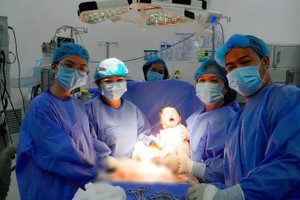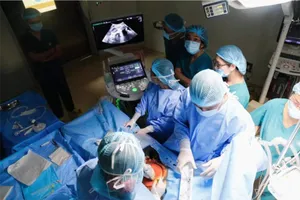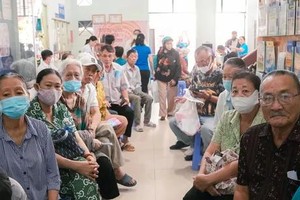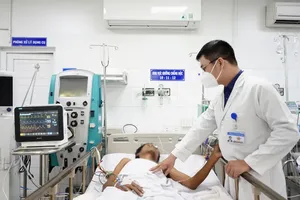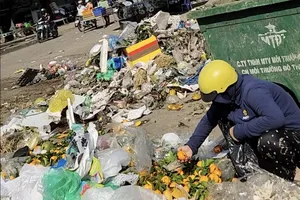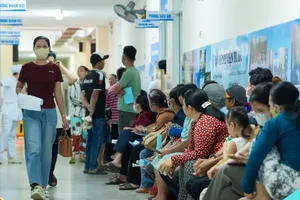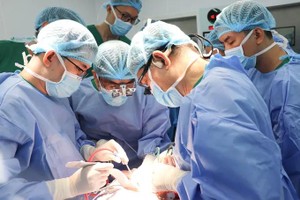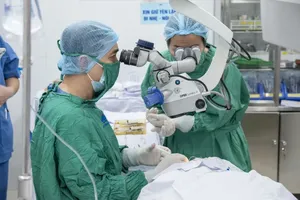 Patients with osteonecrosis of the upper jaw receive treatment at Cho Ray Hospital
Patients with osteonecrosis of the upper jaw receive treatment at Cho Ray Hospital
As per statistics of the Central Hospital of Odonto-Stomatology in Ho Chi Minh City, every three months, the hospital averagely received one case with osteonecrosis of the upper jaw previously, but in the past five months, the unit has recorded 16 cases. However, hospitals have not confirmed if these cases are related to Covid-19 or not.
A 46-year-old woman in District 5 spent nearly six months for treatment at many hospitals without getting rid of jaw pain and facial swelling. In November 2021, she contracted Covid-19, then had a toothache, and 10 days later her face was swollen. She was diagnosed with myelitis and treated for two months.
Vice Chairman of Ho Chi Minh City People's Committee Duong Anh Duc yesterday urged the city health sector to find out the cause of osteonecrosis in the maxillofacial and skull areas in patients who were having Covid-19 that the media reported lately for better treatment.
He applauded the health sector for immediately conducting a meeting with experts to analyze and evaluate after the appearance of this bizarre disease and suggesting that the health sector continue to implement this plan.
After that, she had sinus surgery but the disease did not go away. In May 2022, she was transferred to Cho Ray Hospital for further treatment.
At that time, the patient had osteonecrosis of the maxillary bone, spreading to the temple, and the foot of the butterfly. During surgery, surgeons discovered a large abscess with a lot of pus while opening the cheekbone frame, from the pit below the temple.
According to Dr. Nguyen Van Tuan, Head of the Maxillofacial Surgery Department of the National Hospital of Odonto-Stomatology, there is a sudden increase in this pathology.
Patients all had the same symptoms of toothache, jaw pain, and facial swelling. In case of early detection, necrosis has not spread and has been operated, patients will take antibiotics for 3-6 weeks before jaw restoration. Currently, 13 patients at the Central Hospital of Odonto-Stomatology in Ho Chi Minh City are in stable condition.
Also according to doctor Nguyen Van Tuan, the world medical literature has recorded similar cases. Accordingly, four risk factors suspected to lead to osteonecrosis of the maxilla in post-Covid-19 patients are reported. The first hypothesis is possible due to the SARS-CoV-2 virus attaching to the ACE-2 receptor causing concentration in the mucous membranes of the nose and mouth and microvascular occlusion of the maxillary bone.
People with Covid-19 experience hypercoagulability, causing blood vessel blockages that do not nourish bones well. Second, it is possible due to the use of anti-inflammatory drugs or due to bacterial infection, or fungal infection. Finally, patients with diabetes cause vascular complications and reduce resistance, so the body is susceptible to superinfection.
Regarding a cluster of patients with upper jaw bone necrosis at Cho Ray Hospital and the Central Hospital of Odonto-Stomatology in Ho Chi Minh City, physicians said that all patients had Covid-19. Previously, doctors of Ho Chi Minh City Otolaryngology Hospital also recorded several cases of upper jaw bone necrosis.
Many experts fretted that there may be many similar cases but they have not been reported. If patients have not received proper treatment promptly, they can die from bone necrosis and severe inflammation.
According to Professor-Dr. Tran Minh Truong, Vice President of the Vietnam Association of Otolaryngology, former Deputy Director of Cho Ray Hospital, the warning signs suggestive of the cases are severe pain during Covid-19 infection or after having tested negative for SARS-CoV-2.
Many patients have osteonecrosis of the jaw, the bone structure is destroyed, making the tooth wobbly as if it is about to fall. Patients suffered much pain and had bad breath, even if their tooth is extracted, the pain did not abate.
Up to now, the Ministry of Health has not had a treatment regimen for this disease, so even if the disease is diagnosed correctly, there have been widespread public debates about the treatment methods. A series of cases have been recorded unprecedentedly in a short time, so medical workers faced difficulties in giving explanations to patients and family members; however, without surgery, the condition of patients will get worse.
On the afternoon of July 13, Associate Professor Dr. Tang Chi Thuong, Director of the Department of Health of Ho Chi Minh City, said that the department has asked hospitals in the area to report the situation of receiving and treating patients with necrosis of the upper jaw bone after having Covid-19.
It is expected that in the following week, the Department of Health will organize a seminar to listen to experts for seeking the causes of cases of osteonecrosis of the upper jaw in recent years.
